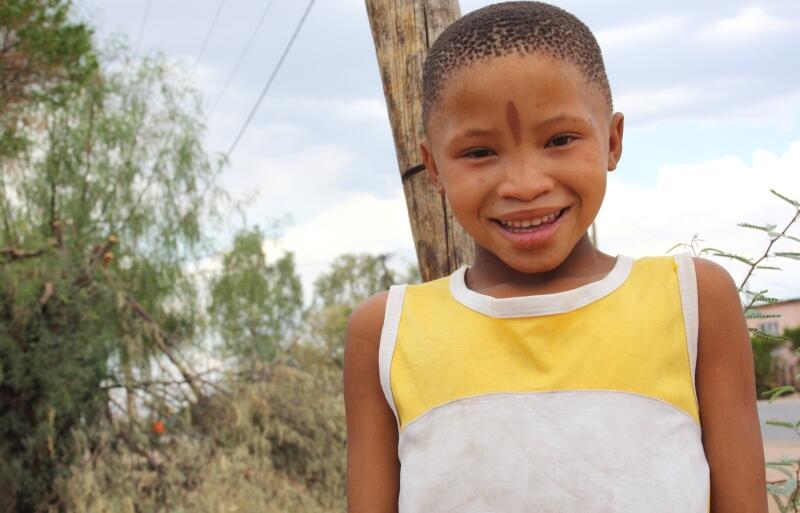GHANZI, Botswana – Xhute is a 12-year-old girl who lives in Ghanzi, about 800km west of the capital city of Gaborone. In 2015, she dropped out of primary school. She was in standard 2.
Xhute’s 26-year-old mother, who is pregnant with her third child, is also a school drop-out. She gave birth to Xhute when she was 16 years old. She lives with her mother, her mother’s siblings, her grandparents and cousins. The family of 13 shares two plastic-covered shacks.
Xhute’s grandfather, who is in his early 40s, is the family breadwinner. He moves the family among the district’s farms where he finds employment, and returns to Ghanzi Township during off season.
I am looking forward to returning to school so that I can achieve my dreams.
Countless challenges
Xhute left school because the family could not afford a pair of shoes for her. Nonetheless, she wants to return. “When I grow up I want to be a teacher so that I can build a house for my parents. I am looking forward to returning to school so that I can achieve my dreams,” she says.
Xhute is one of 2265 students who have dropped out of school in the Ghanzi region since 2010. The dropout rate for Ghanzi is 5 per cent, the highest in the country. The national rate is 1 per cent.1
Challenges facing young people
Many girls in Botswana contend with countless challenges – social, economic and health related – that inhibit their access to education. Like most young people in the country, and in Ghanzi specifically, Xhute is at risk of gender-based violence, teenage pregnancy, sexually transmitted infections including HIV, and unemployment on her path to adulthood.

According to the Botswana AIDS Impact Survey (BAIS IV) of 2013, HIV prevalence among young people aged 15-19 years is 6.2 per cent for females and 3.6 per cent for males. Less than half of young people (48 per cent) have comprehensive knowledge of HIV. And less than half of girls aged 15-19 years (45 per cent) know of at least three methods of contraception.
While access to basic health services is high (97 per cent), coverage for adolescents and youth is low. Only 16 out of 335 public health facilities provide youth-friendly services. However, even for those that do provide them, the quality of the service does not meet the World Health Organization’s global standards for youth-friendly health services.
In Botswana, almost all primary school-aged children (over 90 per cent) are in school and almost all of them progress to junior secondary school. However, comprehensive sexuality education (CSE) is not offered in schools and access to youth-friendly services is very limited.
UNFPA in Botswana supports the Ministry of Health to ensure that youth-friendly services are accessible to young people. The focus of UNFPA’s new country programme, its sixth, is to improve policy and programming for adolescents and young people’s rights to access SRH information and services. UNFPA provides technical assistance in the design of state-of-the-art programmes for most-at-risk youth, and the design and implementation of community and school-based comprehensive sexuality education programmes.
‘The world we want in 2030’
Young people make up more than 60 per cent of the country’s population. Xhute is one of them. Her – and their – future prospects depend on how the country reacts to the challenges facing young people today.
Xhute will be 25 years old in 2030, the year for achieving the targets of the Sustainable Development Goals (SDGs). The future of Botswana – and that of the world – is inextricably linked to the fate of Xhute and the young people of today. Ensuring that all 17 goals are met to transform the lives of young people is key to how the current generation of 12-year-olds will play out over the next 13 years.
If today’s large cohort of young people cannot find employment and earn a satisfactory income, the youth bulge in Botswana could undermine economic growth, peace and security. The extent to which the country will be able to benefit from its youth and reap the demographic dividend depends heavily on the investments made today.
The key policy actions needed are those that expand opportunities for youth, give them the skills they need to participate fully in the economy and public life, and promote healthy behaviours. It is these investments that will ensure that Xhute will be healthy and contribute to her family’s wellbeing with gainful employment.
UNFPA is providing advocacy and technical support for the integration of CSE into out-of-school programmes. Advocacy and technical assistance is also provided for the development of a national strategy to prevent teenage pregnancies.
Investing in young people, especially girls, is one the best decisions that a society can make from an economic perspective.
Investment is key
“Investing in young people, especially girls, is one the best decisions that a society can make from an economic perspective,” said Mareledi Segotso, UNFPA Botswana’s Assistant Representative.
“Key investments are needed in health, education, economic reforms, job creation, governance and accountability. Young people have a long working life in front of them; if they are supported they will be able to pay back several times the value of such investment. The demographic dividend has added strength to the rationale for investing in adolescents and youth.”
Attaining the demographic dividend is not an automatic process. It is something that is built towards today in order to reap the benefits later. Timing is therefore critical. If Botswana is to benefit from a demographic dividend, the time to invest is now.
The most important resource for development is human capital. This is why the time is right to invest in young people like Xhute.
By Nchidzi Smarts
1 Statistics Botswana: Education Statistics Report 2012


